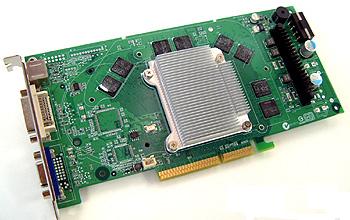Flashing a Video Card BIOS
Before an Operating system like Windows XP loads and the software drivers take control of your video card's functions, the video BIOS initializes the card. As soon as it receives power from the motherboard, the BIOS activates the card and identifies itself to the motherboard BIOS.
At this point, the graphic processor and video memory clock speeds are also set by the BIOS, though these may be overridden by the drivers or other utilities once the operating system has loaded.
In short, the video BIOS starts and identifies the card, and provides its initial crop of settings.
In the current age of the unified video driver, where manufacturers like ATI and Nvidia provide a single set of drivers for all their video products, the way the video drivers interact with a card also depends on how the card is identified by the BIOS. Thus, 'new' features can be activated by using a different BIOS on the same Graphics processor.
 Why Flash It?
Why Flash It?
Well, there are several good reasons to flash your video card's BIOS. For one thing, some manufacturers have and will release BIOS updates for their video cards, though this has become considerably rarer in the last few years. These updates may increase the stability of the card, eliminate glitches and problems, and possibly increase performance. A more compelling reason is the lure of getting your video card to perform to its maximum possible potential.
Video card manufacturers have been known to create artificial product divisions, whereby the same model of Graphics processor is packaged with different memory and BIOS settings to create a higher end and lower end version of what is essentially the same item. As the video BIOS governs the speeds the GPU and memory can be set to, changing this can have a huge effect on video card performance and overclockability.
The same graphics processor can be set to run at a lower speed so that the company can have entry level and high-end versions of the same part without the expense of commissioning two different graphics core designs.
A good recent example of this sort of thing is with ATI's Radeon 9800 PRO and Radeon XT cards. Many 256MB 9800 Pro cards (and some 128MB ones too) actually use the same graphics processor core as the 'faster' and more feature laden 9800 XT cards. A simple BIOS flash will increase the speed of the card and enable features that were not previously available to the 9800Pro, like temperature monitoring and the 'overdrive' driver overclocking option.
Please note that this is a possibility specific to the one type of video card only, and cannot be duplicated with other products. Similar processes exist for various other types of video cards though. A quick bit of research on the Internet will turn up many accounts of this.
It's fair to note at this point that many of the gains achieved by successfully flashing a new BIOS onto your card can be directly attributed to the new BIOS increasing the GPU and memory speeds. These gains can also be realized with overclocking, at less risk to the card. What cannot be duplicated though, are the addition of new features and the sheer pleasure of seeing your video card identified as a model that costs $100 more.
The procedures for Flashing an ATI BIOS
Now let's look at the actual procedure of flashing your video card's BIOS. Please keep in mind that this procedure can render your card useless if something goes badly wrong. Proceed at your own risk, and make a BIOS backup as detailed below.
! Warranty And Safety Issues !
Be aware that flashing your video card BIOS in an attempt to change or upgrade the card will certainly void any warranty you may have with the manufacturer, so perform this procedure at your own risk. Certain manufacturers, most notably ATI, consider any attempt to flash the BIOS as a violation of warranty terms and will withdraw support even if you were not attempting to change the card's capabilities. Also note that if you attempt to considerably increase the performance of your video card by this method, as in overclocking, you are increasing the stress on the hardware, which may cause it to fail.
BIOS Flash for ATI video cards
What you will need:
1. At least one blank 1.44 HD floppy disk
2. A copy of the FLASHROM utility
3. A compatible BIOS file for your video card. Try here or search the web for other compatible BIOS files and information.
4. Any drivers that may be required. If you are attempting to change your BIOS to that of a different video card, you should check to see if it requires different drivers.
1. Making an ATI BIOS flash boot disk
All video BIOS flash operations need to be performed in DOS, so we will need to make a DOS boot disk first. There are two easy ways to do this; the first is to go to bootdisk.com and download one of the DR DOS disk image files they link to on the website. Run the .exe file to create a clean DOS boot disk in your A:\ drive.
Otherwise, you can create a boot disk from within Windows XP by inserting a floppy and opening 'my computer' then right clicking on the 'A:\' drive and choosing 'format.' From the format window, check the 'create an MS-DOS startup disk' option and click 'ok.' Now that you have a DOS boot disk, copy the BIOS file you downloaded and the FLASHROM.exe file onto the disk.
2. Making a backup of your ATI video card BIOS
Before we flash the card with the new BIOS version or type, you should always make a backup of the current BIOS, in case of disaster.
To do this boot your computer with the BIOS flash disk we just created. At the 'A:\' prompt, type 'flashrom.exe -s 0 backup.rom' and press ENTER. The FLASHROM utility will create a backup of your video card's BIOS (backup.rom) on the BIOS flash disk. We can use this to restore your card's original BIOS if necessary.
3. Flashing your ATI video card's BIOS
To flash the BIOS of your ATI card, type the following from the 'A:\' prompt:
'flashbios -p 0 (the name of the new BIOS file you downloaded including the file extension)' then press enter.
FLASHROM will proceed to overwrite your old BIOS with the contents of the new file. If you see any error messages, make sure not to restart the system. Instead, consult the troubleshooting section at the end of this article.
Note that in certain cases (such as if you are trying to replace your video card's BIOS with that of another card) the procedure may halt if the BIOS types do not match. In this case, you can use a separate switch (-f) to force FLASHROM to do the operation despite the potential problem. You should only do this if you are absolutely sure that the new BIOS file will work with your card.
To force the BIOS flash type:
'FLASHROM -f -p 0 (the name of the BIOS file you downloaded including the file extension)'
If everything seems to have gone correctly, restart your system. Watch the post screen for the video card information (it will be the first item displayed on the screen after you boot). Make sure the new BIOS has taken hold and that your operating system boots correctly. Depending on the BIOS version you used and the video card, you may need to install new drivers too.
Congratulations! You have successfully changed your video card's BIOS.




